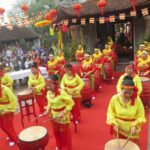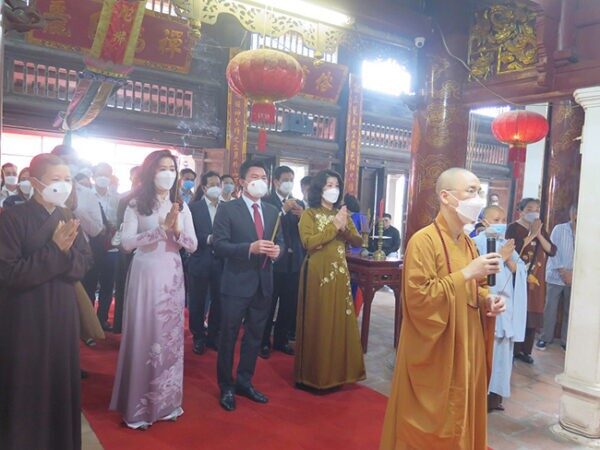
Delegates attending the incense offering ceremony – Photo: Dong Da E-portal
Lang Pagoda, also known as Chieu Thien Tu in Chinese, is an old pagoda in Lang hamlet, which is today located in Lang Thuong ward, Dong Da district, Hanoi. The pagoda was established during the reign of King Ly Anh Tong (reigned from 1138 to 1175) and serves as a shrine to venerate Tu Dao Hanh, the Third Saint Patriarch of the Ly dynasty, and to embody his power as King Ly Than Tong.
Lang Pagoda, with an area of 17,917m2, is located on campus. The Lang pagoda includes 100 large and tiny compartments, and the gate (Tam Quan) has a slight trace of the ritualism of the royal palace in the Le Trung Hung period, with four square columns and three small curved roofs affixed to the side of the column and roof. The center is higher than the two roofs, and the bottom contains elephants on both sides. The middle of the gate has four words written on it: “Thien Thien Khai Thanh” (Troi thien sinh Thanh), on the right is “Tue Nhat,” and on the left is “Tu Van.”
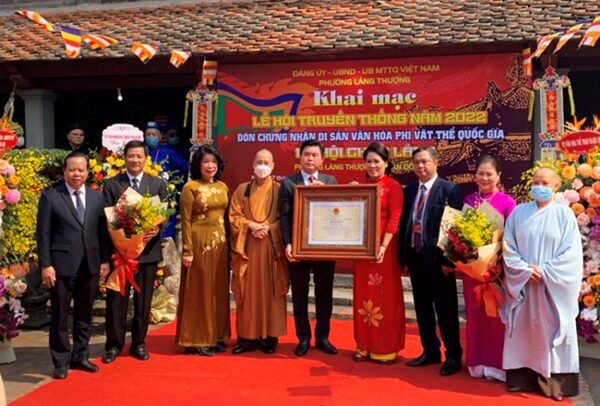
Leaders of Dong Da district and Lang Thuong ward received the Certificate of Lang Pagoda Festival intangible cultural heritage inclusion – Photo: CGTTTP
The Bat Giac house, also known as the Bao Cai home, is the temple’s most notable architectural feature. This is where the Saint’s palanquin is set before the celebration, in the midst of the temple yard, with a stack of matches, two floors, and sixteen roofs covered in dragon scales with curved blades, very lovely. The roof is adorned with four dancing phoenix patterns with delicate lines. The roof above is covered with eight coiled dragons, representing the eight Ly rulers.
Lang Pagoda presently houses a massive collection of relics, including numerous rare and valuable relics of high aesthetic value, such as an altar carved with a dragon in the 17th century and two palanquins painted with gold and gold and carved with art dragons in the eighteenth century. There are also 198 round figures of all sizes in the pagoda, 39 of which were created in the 17th – 18th century by Le Trung Hung, while the rest are in the style of the Nguyen Dynasty. A statue of King Ly Than Tong (1128 – 1138) sitting on a throne (made in jackfruit wood) and an outdoor figure of Tu Dao Hanh woven with painted rattan can be found in the harem. The two horizontal murals above bear the Chinese characters “Ly Trieu Thanh De” and “Thanh Cung Van Tue”; the bell “Dai Hong Chung” and a huge bronze altar created in 1738 can be found on the two higher floors. Lang Pagoda also features 11 Sac monasteries named after the deified Zen Master Tu Dao Hanh, as well as 13 stone steles.
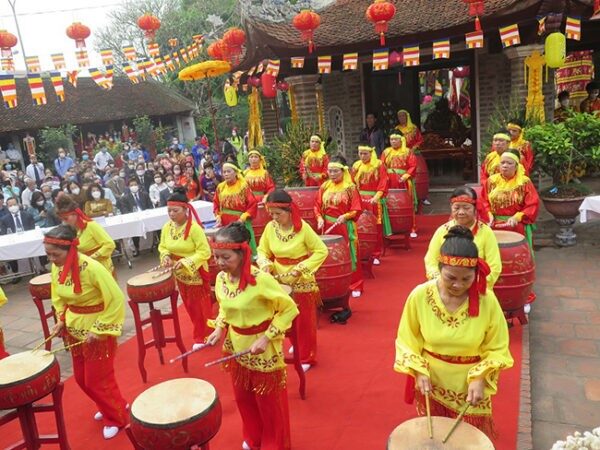
Drum performance for the Lang Pagoda Festival 2022 opening ceremony – Photo: Dong Da E-portal
Every year on the 7th day of the 3rd lunar month is the day of Tang Khanh – the day when the Tu Zen master died in Thay Pagoda, which is also the day when King Ly Than Tong was born, so this day is considered as the major day of Lang Pagoda Festival and Thay Pagoda Festival.
The ancient Lang festival took place within 10 days. Starting from the 5th day of the 3rd lunar month, the people of Lang village will go down to Tam Huyen pagoda to visit their father. On the 7th day of the third lunar month is the main festival, in the year when life is good, the people organize the procession.
The most attractive Lang festival is the palanquin procession with the participation of 9 villages (including 7 villages of Tong Ha and Thuong Dinh Village, Thuong Yen Quyet village). During the festival, there is a procession of Saints from the Tu family to Hoa Lang Pagoda to visit Thanh Mau and narrate the story of the Holy Spirit eradicating evil on the To Lich River. When the palanquin procession from Lang Pagoda to Cot Gate, the palanquin wades across To Lich river called Do Ha and then stops on “Hon Ngoc” for Hang Do to transition to the riverfront; there is a dragon dance team encircling the Hon Ngoc.
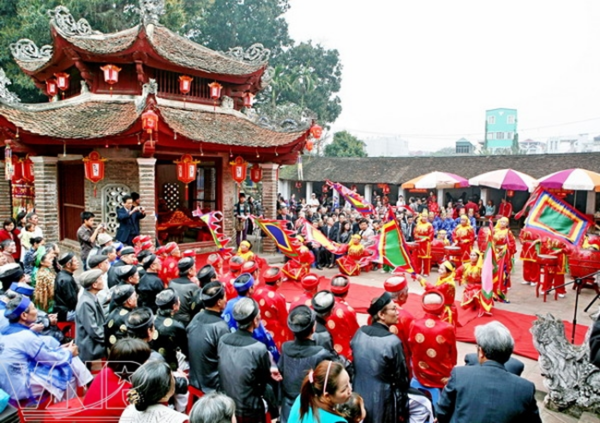
Pictures of Lang Pagoda Festival – Photo: Dong Da E-portal
In addition to traditional offerings, the Saint procession conducts enjoyable events like as martial arts, cock fighting, human chess, and pot beating, particularly with the custom of blowing rice while strolling and blowing rice around the octagonal home, dancing, and singing… Following the procession, the dignitaries and elders of the commune and three villages, respectively, assemble to worship at Nen Pagoda, Lang Pogoda, and Ung Thien Communal House (Lang Ha) beginning on the eighth day. This is a distinctive characteristic of the Temple of Worship, which is regarded as suspended in the Thay Pagoda and Lang Pogoda. The concluding ceremony was place on March 15.
The Lang Pagoda Festival is the spring festival of a region that includes many villages on both sides of the To Lich River. The festival not only gathers local people but also attracts people from other localities to attend.
With the above values, Lang Pagoda was ranked at the national level in 1962 and on December 20, 2019, the Minister of Culture, Sports and Tourism issued Decision No. 4611/QD- BVHTTDL to celebrate the ceremony. Lang Pagoda Festival on the list of national intangible cultural heritage.
Nhat Linh (t/h)

